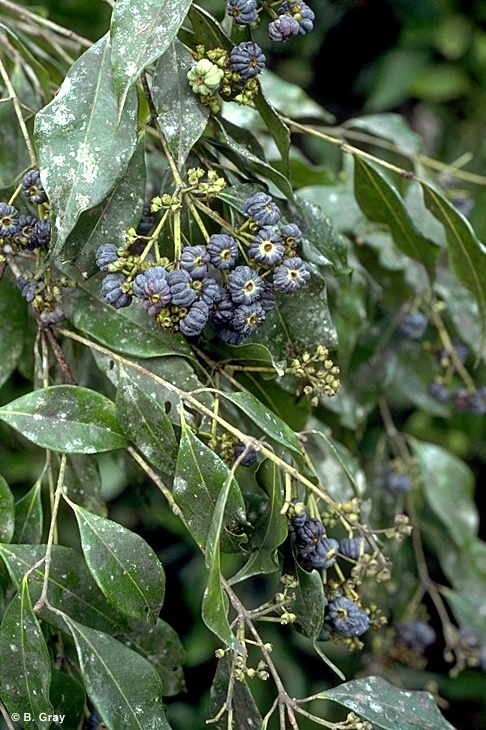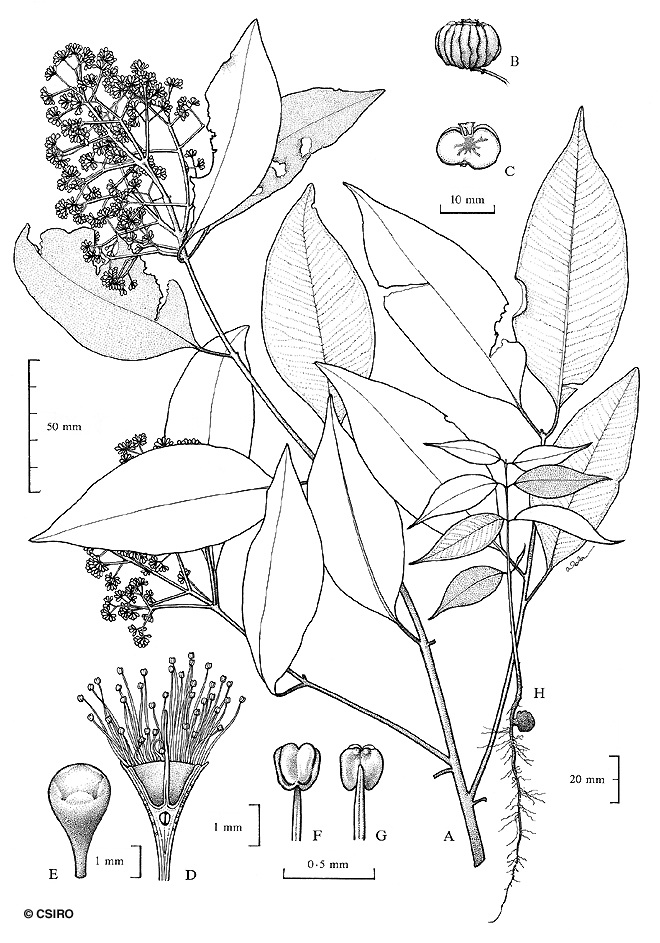Australian Tropical Rainforest Plants - Online edition
Syzygium unipunctatum (B.Hyland) Craven & Biffin






Craven, L.A., Biffin, E. & Ashton, P.S. (2006) Blumea 51(1): 139.
Bark in the Wood; Watergum; Satinash, Rolypoly; Rolypoly Satinash
Sections of bark included in the wood. Living bark layer quite thin, about 3-4 mm thick. A thin cream layer generally visible beneath the subrhytidome layer before the first section of the outer blaze.
Inflorescence terminal and in the upper axils, bracts deciduous, absent at anthesis. Calyx tube (hypanthium) + pedicel about 2.5-4.5 mm long, calyx tube (hypanthium) about 1.5-3.5 mm diam., calyx lobes triangular to somewhat rounded, about 0.3-0.7 mm long. Petals +/- orbicular about 1.5-2.2 mm diam., oil dots sometimes obscure, about 30-80 per petal. Outer staminal filaments about 2.5-7 mm long, anthers about 0.2-0.3 x 0.2-0.3 mm, with two, small, inconspicuous glands, terminal, near the back of the anther. Ovules pendulous from placentas near the apex of each locule, ovules about 2-3 per locule. Style about 3-6.5 mm long, shorter than the stamens.
Fruits very depressed, almost discoid, attaining about 8-12 x 11-15 mm, apex excavated, surface longitudinally ribbed or grooved, calyx lobes persistent, but inconspicuous, pericarp forming a very thin skin (about 0.05 mm thick) around the cotyledons, testa absent or indistinguishable from the pericarp. Seed solitary, only slightly smaller than the fruit, pericarp free from the cotyledons but not easily separable because of the matching grooves and ridges in the surface of the cotyledons and the pericarp. Cotyledons glandular, ruminate, with an amorphous, pale (not dark, even though the structure is pale it may be darker than the surrounding tissue in the cotyledons) central structure, with a distinct vascular connection with the base of the fruit. Radicle basal. Cotyledonary stipules present, small and inconspicuous.
Endemic to NEQ, widespread in the area. Altitudinal range from sea level to 1200 m. Grows as an understory tree in well developed rain forest on a variety of sites.
Becoming very popular in cultivation for its beautiful flushes of pink to red new growth and the blue pumpkin-like fruits.
This species has no commercial value because it seldom grows to millable size and because the bark included in the wood renders the sawn timber structurally doubtful. Wood specific gravity 0.90-1.00. Hyland (1983).





